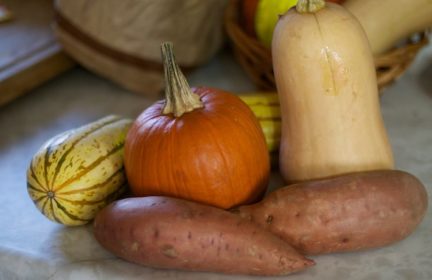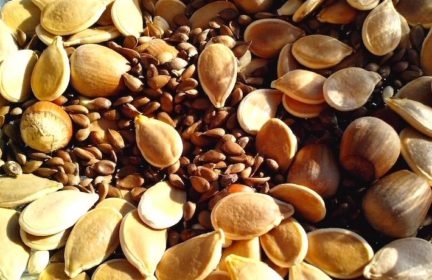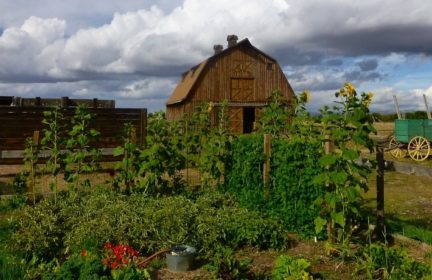Gardening books – recommendations and reviews?
This is a thread to review and recommend (or discommend) gardening and small-scale livestock books. I worked with John Ramsey on revising The Prepared’s books page (the revisions aren’t live yet), but I know that there are many more interesting books than what fit on that list. I thought it would be useful for community members to be able to recommend the books they’ve found most helpful and share about things they are reading.
To keep things organized, I suggest making each book review a separate post (even if it’s just a short paragraph), rather than listing multiple books in one post.
-
Comments (14)
-
C P.Contributor - August 12, 2020
Compost Everything by David the Good – Recommended
I think that every prepper-gardener should read this book… but it’s not the shelf-reference I was hoping for.
Good’s main mission in this short text is to expand the reader’s vision for what can be composted and how composting can be done. He succeeds in that goal admirably. In short, punchy chapters like ‘Anarchist Composting’ and ‘Redneck Vermiculture’ he lays out composting techniques that some of us have never heard of or have just assumed were too complicated or inefficient to be worthwhile.
With every topic he explores, he insists that composting can be much easier and simpler than it is made out to be and provides simple, basic steps for the reader to follow. His personal stories are memorable, entertaining, and humble. There is no pretense here. The stories of trial and error encourage the reader to experiment with new things themselves.
Reading the book, I was convinced to try vermiculture to compost our junk mail and Amazon boxes, and to try out Melon Pit composting, in which high-nitrogen items like meat and bones are mixed with wood chunks and buried 2-3 feet deep and then planted atop of. Reading his instructions, I regretted that I had thrown out all of the bones and fatty refuse from a recent adventure in making head cheese. I could have used them to give a massive boost to a new tree or bush.
However, the book has a couple of weaknesses. First, in his quest to make composting easy and unthreatening, Good skips explaining most of the science. This makes the text simple and accessible, but it also leaves the reader wanting more explanation. For instance, in the second chapter, Good suggests that excessive concern for carbon-to-nitrogen ratios (aka brown-to-green ratios) is one of the things that needlessly turns people off on composting. But then a few chapters later, discussing sheet composting, he encourages the reader to pay attention to having a brown-green mix. Similarly, he extolls the virtues of piles of tree trimmings for improving the soil, but then in another chapter he warns the reader to bury wood chunks, not wood chips, to avoid binding up nitrogen in the soil. These tensions create the feeling that something isn’t being fully explained. A better approach would be to explain how carbon and nitrogen work in composting, and then note for each technique whether or how maintaining a good C-N ratio applies.
Second, the book skips some important details. In the chapter on vermiculture, he gives great advice, but seems to leave out a crucial step: how to empty your vermiculture composter and extract the compost without losing your worms. However, he does refer the reader to another, more authoritative text (Worms Eat my Garbage by Mary Appelhof). The chapter on humanure (composting human feces) is intriguing, but Good strongly exhorts the reader to get the expert advice of The Humanure Handbook by Joseph Jenkins. I can understand and respect Good’s desire to not overstate his own expertise or to steal other authors’ intellectual capital. But the result is that some of the techniques in the book can’t really be used well without buying another one.
The bottom line is that this is a great book to expose you to new things and many of the techniques in the book (like anarchist composting, melon pits, and using fish guts) can be used with just the guidance contained in this book – plus probably a bit of trial and error from the reader. However, I wouldn’t buy it as a shelf reference expecting that it will be all you need to guide you through making your own fertilizer during hard times. It might be enough, but you would be better served by complementing this text with the detailed composting discussion found in How to Grow More Vegetables by Jeavons or some of the specialists texts referenced by Good.
-
Josh CentersContributor - October 9, 2020
I’m a big fan of David’s and I recommend all of his gardening books.
-
-
North Coast - August 12, 2020
My introduction to composting was Worms Eat My Garbage by Joanne Olszewski and Mary Arlene Appelhof. I learned enough there to be confident building and maintaining a worm bin under my sink in the kitchen corner of my two-room apartment. I haven’t kept it up now that I have a yard, so it’s been years since I read it, but it was a big step in my learning as a gardener!
-
chicksnhens - August 12, 2020
The Holistic Orchard by Michael Phillips – Recommended
A dense read that provides everything you need to know about home orcharding. Most of the focus is on apples, but also provides valuable information on managing other fruits too. The holistic approach means most of the products that are recommended for tree care are sustainable and DIY (wood chips, compost,) which is great if you are concerned about sustaining your plants without access to supply chains. Biggest con is the sheer amount of information – this isn’t light reading and is more of a reference book for growers. Highly recommend.
-
C P.Contributor - August 12, 2020
Have you had good results using its recommendations? I’ve been thinking about buying it, as I am trying to get better harvests from our fruit trees.
-
-
C P.Contributor - October 9, 2020
Gardening When It Counts by Steve Solomon – Recommended
I came across this book on a list of ‘best gardening books’ on David the Good’s website. It is a fascinating read, brimming with practical advice.
In many ways, Solomon’s gardening style is the exact opposite of Jeavons / How to Grow More Vegetables. HTGMV says double dig, you don’t need to fertilize (just use compost), plant densely, and mulch heavily. Solomon says don’t bother double digging, use organic fertilizer plus compost, spread your plants far apart, and don’t mulch. It could be confusing, but Solomon is very aware of the tension and explains clearly why he is giving such contrary opinions.
In many ways, what Solomon is explaining is why old-school, pre-HTGMV gardens looked the way they did – long rows of widely space vegetables growing on bare dirt. He argues that this style of gardening gives plants more room to grow, less competition, and more access to water, and that the lack of mulch makes it easier to hoe out weeds. He claims that it yields bigger plants (e.g., bigger heads of cabbage or bigger beets) that take less time to harvest, clean, and preserve. Solomon is very credible (he used to run a seed company and is the author of multiple gardening books, one of which – Gardening West of the Cascades – is in its 7th edition) and while he is certainly opinionated, he is also writing from his experiences.
I found many of his claims convincing because his predictions match with my experiences – namely that fertilizing my garden beds with just compost has led to declining yields over the years and that closely spaced plants are often relatively small when harvested. I’m trying wider spacing in my fall garden and I look forward to the results.
The book is very systematic, and gives advice on preparing the soil, sourcing seeds, plantings seeds, weeding, and even selecting and maintaining tools. I found the advice on how properly sharpen and use a hoe especially useful. The section on individual plants is excellent. Solomon divides vegetables according to how difficult they are to grow (especially how fertile the soil needs to be), prioritizes them according to which are most important as food sources, and then gives tips on growing and harvesting each. This section only takes up one chapter of the book too, unlike some volumes where 1/3 or more of the book turns out to be an encyclopedia of plants instead of a discussion of gardening.
I didn’t agree with everything in the book. I find that soil health is much better when I mulch heavily. I thought that Solomon makes composting unrealistically complicated; I much prefer David the Good’s book on this. But overall, I felt like a learned a lot.
The book’s main limitation is that Solomon’s gardening style requires more space than many people have or are willing to use. Solomon estimates that his garden (which feeds two adults for a year) is 2,000 square feet of growing space (not counting paths between rows), plus another 2,000 square feet of fallow ground. (He shifts the garden between these two plots every 3-4 years.)
Bottom line: Gardening When It Counts may be a great book to start with if you have a large yard or live in the country and are willing to devote a lot of space to your garden. For suburban gardeners starting with HTGMV or Square Foot Gardening, it may be useful to read Gardening When It Counts after you have a few years of experience – it will give you new techniques to experiment with and may provide answers to any frustrations you’ve developed.
-
Josh CentersContributor - October 10, 2020
That is an excellent book, especially the section on sharpening garden tools, which is something I had never considered before. But Solomon is notorious for his strong opinions, which are just that, opinions, and you know what they say about opinions…
It’s good to keep in mind that gardening isn’t religion (unless you’re one of the no-till cultists or are into biodynamics). Most experienced gardners experiment constantly. For instance, David the Good regularly talks about how he hates raised beds with borders, yet I’m watching a video right now where he clearly has some bordered beds. That’s not hypocrisy, that’s just trying something out and seeing how it works. Some gardening authorities get really stuck in a certain way of doing things, because they’ve worked well for them, but it’s like dieting: some things work better for some than others.
That’s why I recommend a variety of books to aspiring gardners. It’s good to have a “toolkit” of techniques so you have options to try and blend as you see fit.
Interestingly, DTG is a friend and student of Solomon’s, even though he often does things much differently. He recently live-streamed a Skype call with Solomon where Steve walked him through mixing amendments to improve his soil.
-
-
10 Canadian Winters - December 31, 2020
I’m in Quebec, so a lot of the books I read have to do with gardening in short seasons.
I really enjoy the Mini Farming Bible by Brett Markham. It’s so far the book which goes into the most detail about soil, composting, pests, etc. I’ve found it to be very complete and allow me to learn a lot in a very scientific way what happens in the soil.
For extending seasons, I appreciate Niki Jabbour’s The Year-Round Vegetable Gardnener. She discusses hardy varieties of crops which will do well in colder climates. She also discusses cold frames and other methods to create micro climates for the plants you are growing.
There’s also Vegetable Gardening in the Northeast by Marie Iannotti. I enjoy this one because it gives you a TODO list every month based on what zone you are in. It also lists many vegetable varieties.
-
Gideon ParkerStaff - December 31, 2020
Thank you for the great suggestion! I’m going to have to look into that book this upcoming year.
-
-
RedneckContributor - December 31, 2020
I have a garden, orchard & nut trees. I grow apples here in the deep south and there in not much information applicable to doing such. Years ago I met Michael Phillips at a Ciderdays event up in Massachusetts where he was talking about growing apples organically. He said it could be done up in New Hampshire (I think that is where he is from) but even a little further south in Massachusetts it was harder. I didn’t bother asking him about Mississippi. 🙂
Point being, my experience is every location is different and each will have different issues with their own growing conditions. So don’t expect much from a book about specifics. Yes, you can get great basic info such as soil amendments and how to layout a garden but you will likewise get info that won’t work for you.
I’ve found out the only real way to learn is just to dig in & do it. Learn from trial & error. Can’t begin to tell you how many fails I’ve had but with each fail I’ve learned something. Of my over 150 apple trees, I’ve replaced over half with different varieties & different rootstocks. In the garden, I’ve struggled with some varieties that sound great online but then find a different variety that works best for me.
The best sources of info I’ve found is not from books but from websites from local agricultural universities. For me in my area, Mississippi State & Univ. of Arkansas have provided lots of info when I want to research growing a particular item.
Best garden book I have is Buffalo Bird Woman’s Garden, which gives great insight & detail on how native Americans could grow & store so much food with out any modern tools or additives.
-
LBV - December 31, 2020
I would recommend general gardening books, but it really depends on where you live and how best you learn and what level your gardening knowledge is. My best recommendation is to join your local library and check what is there. If there is a book you really love and don’t want to give it back – then that is one to buy.
Organic Gardening the natural no-dig way by Charles Dowding. He is English, and his manner of growing dispels a number of myths that are common. Growing directly on the ground, saves money and his multi-sowing technique saves time. He also has a channel on youtube that can give you an idea of what he is about. If you know the basics, then you could probably pick up most stuff from you tube. It is worth noting that digging is sometimes necessary. If you have a hard pan that plants can’t get through, then digging may be necessary. However, Charles Dowding keeps two test gardens – both planted the same, but one is dug, the other isn’t.
-
Gideon ParkerStaff - January 1, 2021
Great suggestion! I’ve gotten many books at the library first to make sure it is one that I would want to buy before buying it.
-
-
LBV - December 31, 2020
https://www.heritagefoodcrops.org.nz/ is a site with research relating to nutrients in our food. It is clear that industrialisation of food has actually bred nutrition out of our food. Our choice of cultivars matters as much as site and method of growing.
-
North Coast - August 12, 2020
All New Square Foot Gardening by Mel Bartholomew is also one I’ve been leaning on for a couple years. Much of this content can be found online but I do think this book is handy to have the info in a single place, especially info about plant spacing. The soil composition is something I’ve used, too, but it can be expensive as an upfront cost, and the garden design piece is both independently worthwhile and requires no additional expense.
-
- Fun ways to teach kids outdoor/survival skills - 12 hours ago
- News for the week of 2025-06-30 - 1 day ago
- News for the week of 2025-06-23 - 1 week ago
- News for the week of 2025-06-16 - 2 weeks ago
- News for the week of 2025-06-09 - 3 weeks ago
This forum is heavily moderated to keep things valuable to as many people as possible. Full community policies are here. The basics:
- 1. Be nice to each other.
- 2. Stay focused on prepping.
- 3. Avoid politics, religion, and other arguments.
- 4. No unfounded conspiracies, fake news, etc.
- 5. Debate ideas, not people.



